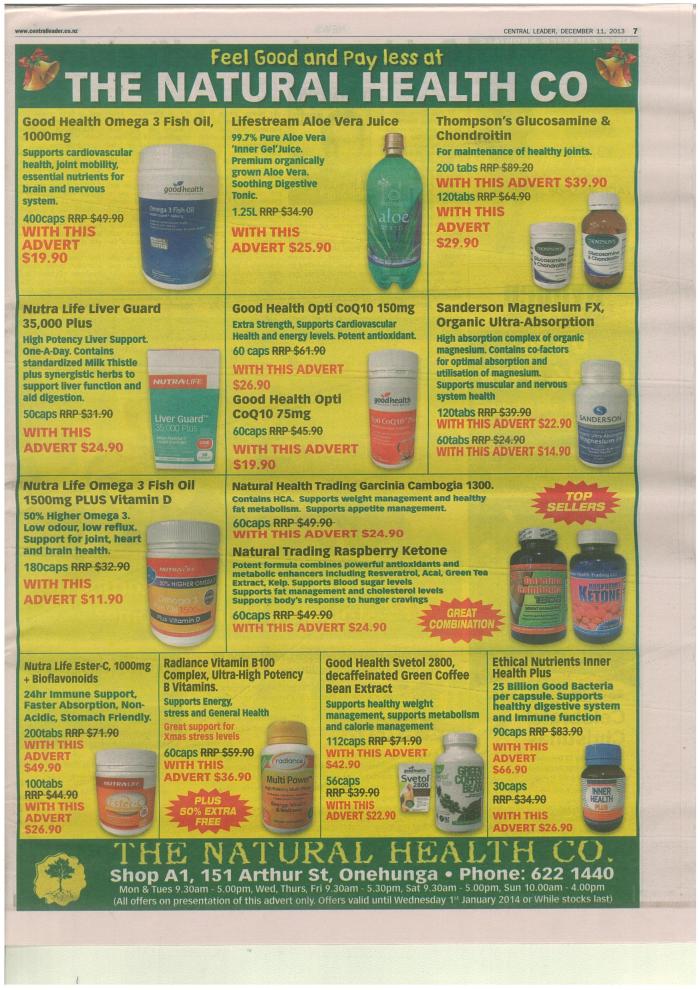By definition, when it comes to telling the truth, advertisers have a conflict of interest. They want you to buy whatever they’re advertising, so they’re going to try to show it in its best light. Often, this means using psychological tricks, and these tricks generally work best when consumers aren’t aware of them.
For example, most people are aware that the reason why products cost $39.90 instead of $40.00 is that they sound significantly less expensive, even though the difference is miniscule. Consumers tend to be aware that advertisers are prohibited from “false advertising” – they can’t tell us anything that isn’t true – and that advertising is regulated. This tends to give us a sense of security when it comes to taking advertisers at their word. Unfortunately, there are a lot of ways in which medical advertisers in particular can, and do, take advantage of this.
In today’s edition of my local newspaper, there was a full page ad placed by “The Natural Health Co”. This advertisement contains a lot of these tricks that can be used by medical advertisers to mislead consumers without technically breaking the rules, so I thought I’d use it as a case study to point out some of these tricks.
First thing’s first, here’s the advertisement:
The most common trick is one that I’ve written about before. The industry regulators of medical advertisements in New Zealand draw a distinction between “therapeutic claims” and “health claims”. Although they sound very similar to the consumer, the important difference is that the advertiser is only required to substantiate therapeutic claims. Any health claims they make can be entirely unsubstantiated and, to my knowledge, if they’re false there is no penalty. To quote the guidelines:
Health Claims are defined as claims which support the normal physiological function.
An example of a health claim made in this advertisement is “Supports cardiovascular health”, which is said for a couple of products in this advertisement. As far as I can tell, the reason why advertisers are allowed to make these claims without oversight is that they are not well-defined, and claims like that technically just mean it won’t interfere with normal physiological function, i.e. what would happen anyway in a healthy person.
So, when this advertisement says a product “Supports muscular and nervous system health”, you should interpret it as saying “This product will not interfere with your muscular or nervous system health if you’re already healthy”, and as far as I know they’re not even required to have evidence to support that.
That’s why advertisers can get away with saying that glucosamine and chondroitin supplements work “for maintenance of healthy joints”, despite the fact that statements that these substances have beneficial effects on joint health do not seem to be strongly supported by quality evidence.
Another trick used by these advertisers is making a point out of what is contained in the product. This allows the consumer to draw certain conclusions without the advertiser having to suggest them directly. It’s important to remember that advertisers will always put their best foot forward. If there’s evidence to show that a product has a beneficial effect, then they will say that instead of only saying “Potent antioxidant”.
Most people think they understand what that means (it’s good for you, right?) but, unfortunately, most people also lack the medical expertise required to make good health judgements, and are easily influenced by information like this.
I expect that’s the main reason why health-related testimonials in medical advertisements are prohibited by section 58(1)(c)(iii) of the Medicines Act 1981. Unfortunately, Medsafe seems extremely apathetic when it comes to enforcing this; I’ve contacted them about numerous violations but as far as I can tell they’ve never done anything about them. While it seems intuitive that more information is better, some types of information tend to lead to misinformed health decisions, and testimonials are foremost amongst these.
There are a lot of examples of marketing tricks used in this advertisement. I wouldn’t be surprised if there’s not even a single piece of useful information about the therapeutic properties of one of these products that is backed up by any evidence at all.
Feel free to point out more instances of marketing tricks in this ad, or mention others that you’ve seen in medical advertisements. Unfortunately, “health claims” are almost everywhere in medical ads in New Zealand. Keep an eye out for the word “supports”, as it’s usually a strong indicator that they’re making a health claim and therefore likely don’t have evidence to support it.

have a look at this example